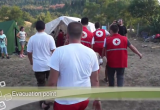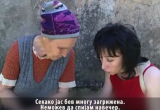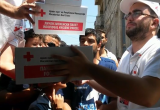NTERNATIONAL HUMANITARIAN LAW

The implementation of international humanitarian law (IHL) as a segment of international law which unites the international legal instruments, applicable in cases of armed conflicts in order to limit the consequences is an issue that the international community and countries pay special attention.
International humanitarian law is a legal and statutory obligation of the Macedonian National society for its dissemination, promotion, implementation and promotion. Macedonia Red Cross, as an National Society and full member of the International Movement of Red Cross and Red Crescent Societies, is implementing its activities in the area of dissemination, starting from the corpus of international instruments on basis of the Geneva Conventions of 1949 and the Additional Protocols of 1977 and the basic documents of the national society like the Law and the Statute of the Red Cross.

International humanitarian law is a set of rules which seek, for humanitarian reasons, to limit the effects of armed conflict. It protects persons who are not or are no longer participating in the hostilities and restricts the means and methods of warfare. International humanitarian law is also known as the law of war or the law of armed conflict.
International humanitarian law is part of international law, which is the body of rules governing relations between States. International law is contained in agreements between States – treaties or conventions –, in customary rules, which consist of State practise considered by them as legally binding, and in general principles.
International humanitarian law applies to armed conflicts. It does not regulate whether a State may actually use force; this is governed by an important, but distinct, part of international law set out in the United Nations Charter.
- The 1954 Convention for the Protection of Cultural Property in the Event of Armed Conflict, plus its two protocols;
- The 1972 Biological Weapons Convention;
- The 1980 Conventional Weapons Convention and its five protocols;
- The 1993 Chemical Weapons Convention;
- The 1997 Ottawa Convention on anti-personnel mines;
- The 2000 Optional Protocol to the Convention on the Rights of the Child on the involvement of children in armed conflict.
International humanitarian law distinguishes between international and non-international armed conflict. International armed conflicts are those in which at least two States are involved. They are subject to a wide range of rules, including those set out in the four Geneva Conventions and Additional Protocol I.
Non-international armed conflicts are those restricted to the territory of a single State, involving either regular armed forces fighting groups of armed dissidents, or armed groups fighting each other. A more limited range of rules apply to internal armed conflicts and are laid down in Article 3 common to the four Geneva Conventions as well as in Additional Protocol II.
It is important to differentiate between international humanitarian law and human rights law. While some of their rules are similar, these two bodies of law have developed separately and are contained in different treaties. In particular, human rights law – unlike international humanitarian law – applies in peacetime, and many of its provisions may be suspended during an armed conflict.
- The protection of those who are not, or no longer, taking part in fighting;
- Restrictions on the means of warfare – in particular weapons – and the methods of warfare, such as military tactics.
These categories of person are entitled to respect for their lives and for their physical and mental integrity. They also enjoy legal guarantees. They must be protected and treated humanely in all circumstances, with no adverse distinction.
More specifically: it is forbidden to kill or wound an enemy who surrenders or is unable to fight; the sick and wounded must be collected and cared for by the party in whose power they find themselves. Medical personnel, supplies, hospitals and ambulances must all be protected.
There are also detailed rules governing the conditions of detention for prisoners of war and the way in which civilians are to be treated when under the authority of an enemy power. This includes the provision of food, shelter and medical care, and the right to exchange messages with their families.
The law sets out a number of clearly recognizable symbols which can be used to identify protected people, places and objects. The main emblems are the Red Cross, the Red Crescent and the symbols identifying cultural property and civil defence facilities.
- Fail to discriminate between those taking part in the fighting and those, such as civilians, who are not, the purpose being to protect the civilian population, individual civilians and civilian property;
- Cause superfluous injury or unnecessary suffering;
- Cause severe or long-term damage to the environment.
Humanitarian law has therefore banned the use of many weapons, including exploding bullets, chemical and biological weapons, blinding laser weapons and anti-personnel mines.
However, there are important cases where international humanitarian law has made a difference in protecting civilians, prisoners, the sick and the wounded, and in restricting the use of barbaric weapons.
Given that this body of law applies during times of extreme violence, implementing the law will always be a matter of great difficulty. That said, striving for effective compliance remains as urgent as ever.
They must prevent violations or punish them if these nevertheless occur. In particular, they must enact laws to punish the most serious violations of the Geneva Conventions and Additional Protocols, which are regarded as war crimes. The States must also pass laws protecting the Red Cross and Red Crescent emblems.
Measures have also been taken at an international level: tribunals have been created to punish acts committed in two recent conflicts (the former Yugoslavia and Rwanda). An international criminal court, with the responsibility of repressing inter alia war crimes, was created by the 1998 Rome Statute.
Whether as individuals or through governments and various organizations, we can all make an important contribution to compliance with international humanitarian law.

“This leads to awareness that humanitarian principles are common to all human communities wherever they may be. When different customs, ethics and philosophies are gathered for comparison, and when they are melted down, their particularities eliminated and only what is general extracted, one is left with a pure substance which is the heritage of all mankind”. Jean Pictet, International Dimensions of Humanitarian Law, Signature of the Geneva Convention of 22 August 1864 The idea that mankind must be protected against the scourge of war can be found among all the peoples of Antiquity. It was only in the nineteenth century, however, that considerable efforts were undertaken to make war more humane. The decisive events were the creation of the ICRC in February 1863 and the signature, in August 1864, of the Geneva Convention for the Amelioration of the Wounded in Armies in the Field, which signalled the birth of international humanitarian law.

A rule is customary if it reflects state practice and when there exists a conviction in the international community that such practice is required as a matter of law. While treaties only bind those States which have ratified them, customary law norms are binding on all States. The four Geneva Conventions of 1949, their two Additional Protocols of 1977 and Additional Protocol III of 2005 are the principal instruments of humanitarian law.

Civilians are entitled to protection when, as the result of an international armed conflict or of occupation, they find themselves in the hands of a party of which they are not nationals. See the Fourth Geneva Convention relative to the Protection of Civilian Persons in Time of War of 12 August 1949, in particular Article 4.

Individuals enjoying equivalent status include war correspondents, supply contractors, merchant marine and civil aircraft crews, and civilians who spontaneously take up arms to resist invading forces (Art. 4, Third Geneva Convention of 1949). In case of doubt, any person who takes part in hostilities is presumed to be a prisoner of war (Art. 45.1, Additional Protocol I of 1977). Third Geneva Convention of 1949 relative to the treatment of prisoners of war.

In 1859 Swiss-banker Henri Dunant witnessed the terrible reality of wounded soldiers who remained without assistance at the Solferino battlefield. His initiative to ensure protection for the wounded and sick was soon followed by the signing of the Geneva Convention of 1864. In the course of history that protection was continually refined. It became a detailed legal regime with the adoption of the Geneva Conventions of 1949 and the Additional Protocols of 1977. The first Geneva Convention concerns the wounded and sick, the second extends the protection to the shipwrecked. These treaties specify that the wounded, sick, and shipwrecked must be protected and respected as long as they refrain from fighting. In addition, those who provide assistance should not be prevented from fulfilling their task.

The four Geneva Conventions of 1949 and the Additional Protocols of 1977 provide for the protection not only of the wounded, sick and shipwrecked themselves, but also of the people who look after their physical and spiritual needs – medical personnel, administrative support staff and religious personnel [GCI art. 24, 25 ; GCII art. 36, 37; API art. 8 (c)-(d)], who are not to be attacked and must be allowed to fulfil their medical or religious duties [GCI art. 24-27; GCII art. 36, 37; API art. 15-20; APII art. 9, 10]. International humanitarian law also establishes a comprehensive and detailed protection for medical units, transports and material [GCI art. 19-23, 33-37; GCII arts. 22-27, 34, 38-40; GCIV arts. 18, 21-22; API art. 8 (e)-(j), 12-14, 21, 22; APII art. 11].
The 1954 Hague Convention provides for an elaborate system of protection. It is supplemented by two protocols adopted in 1954 and 1999. Cultural property within the meaning of this convention is defined in its first article.
See Articles 61, 62, 63, 64, 65, 66 and 67 of Protocol I additional to the Geneva Conventions.












































